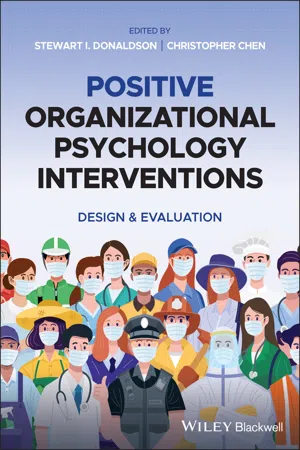Business
Positive Leadership
Positive leadership focuses on empowering and inspiring employees to reach their full potential, fostering a culture of collaboration, and emphasizing the importance of empathy and emotional intelligence in decision-making. It involves creating a supportive and inclusive work environment, where individuals feel valued and motivated to contribute to the organization's success.
Written by Perlego with AI-assistance
Related key terms
Related key terms
1 of 4
Related key terms
1 of 3
10 Key excerpts on "Positive Leadership"
- eBook - ePub
Positive Psychology
An International Perspective
- Aleksandra Kostic, Derek Chadee(Authors)
- 2021(Publication Date)
- Wiley-Blackwell(Publisher)
Furthermore, in a Gallup survey employee engagement was found to be increased when corporate goals are well communicated, and goals are aligned to corporate vision at all levels of the organization. Additionally, employees experience a sense of autonomy and accountability to achieve their workplace goals when they are aligned with corporate goals (Amabile & Kramer, 2012). We prefer to broadly describe the mindset that responds to complex political and economic demands with novel strategies adapted to the changing world as Positive Leadership. Facing the challenges of global competition, mechanistic approaches to development of organizations have their limitations. To overcome these limitations, organizations must identify and nurture new sources of creativity, autonomy, and initiative in their teams. This can be achieved by placing the human being at the center of the value creation process, so that companies can hope to regain room for maneuver and reduce pressure on their employees. Positive Leadership can be defined as the ability to mobilize, facilitate and develop a community of exceptional performers, using individual strengths, positive emotions, motivation, and vision as drivers. Importantly, we do not necessarily view Positive Leadership as a distinct leadership style, but rather as an umbrella construct encompassing several leadership styles with similar characteristics. Positive psychology, or otherwise called the science of flourishing, is a discipline that has challenged the field of human sciences to reconsider the positive aspects of life. Instead of drawing on a “disease model,” it encourages empirical research into factors that enable individuals and communities to thrive and focus on finding the best in oneself. Areas of study include well‐being and its determinants, neuropsychological bases of positive emotions, resilience, creativity, economics of happiness, and positive institutions - eBook - ePub
- Suzy Green, Stephen Palmer(Authors)
- 2018(Publication Date)
- Routledge(Publisher)
Positive Leadership. Facing the challenges of global competition, mechanistic approaches to development of organisations have their limitations. To overcome these limitations, organisations must identify and nurture new sources of creativity, autonomy and initiative in their teams. This can be achieved by placing the thinking and feeling capacity of being human at the centre of the value creation process, so that companies can regain room to manoeuvre and reduce pressure on their employees.Positive Leadership has been extensively researched by Cameron (2008) and elaborated on as a study of what elevates individuals and organisations (in addition to what challenges them), what goes right in organisations (in addition to what goes wrong), what is life-giving (in addition to what is problematic or life-depleting), what is experienced as good (in addition to what is objectionable), what is extraordinary (in addition to what is merely effective) and what is inspiring (in addition to what is difficult or arduous). Cameron (2008) described four strategies that enable Positive Leadership: positive climate, positive relationships, positive communication and positive meaning.Furthermore, the notion of inclusive leadership - eBook - ePub
- Meg A. Warren, Stewart I. Donaldson, Meg A. Warren, Stewart I. Donaldson(Authors)
- 2017(Publication Date)
- Praeger(Publisher)
Organizational culture is an important context that facilitates employee well-being. For instance, an ethical organizational culture predicts high levels of well-being, whereas unethical culture predicts cynicism and low levels of well-being (Huhtala, Kaptein, & Feldt, 2016). Recent studies show that poor relationships and incivility negatively predict employee well-being (Lim, Cortina, & Magley, 2008; Paulin & Griffin, 2016). On the other hand, positive work relationships (Santos, Hayward, & Ramos, 2012) and organizational citizenship behaviors directed to other employees (Kumar, Jauhari, & Singh, 2016) are positively associated with employee well-being. Similarly, a recent study of Swedish auditors found that organizational cultures that emphasized relationships predicted higher job satisfaction, life balance, and life satisfaction (Umans, Broberg, Schmidt, Nilsson, & Olsson, 2016). Further, managerial support and supportive work-home culture that facilitates flexible practices and family-friendly initiatives also predict well-being, particularly for women (Beauregard, 2011). Thus, recent research suggests that cultivating positive work relationships is key to fostering employee well-being.Positive LeadershipLeadership theory and research have received considerable attention in management, organizational behavior, and organizational psychology through the years. Although considerable scholarship has been devoted to leadership traits, skills, styles, approaches, development, and contexts, the POB perspective has offered some additive contributions, especially to authentic leadership, and indirectly to transformational leadership, servant leadership, ethical leadership, and spiritual leadership. Positive Leadership is an umbrella term that encompasses these various types of leadership styles and theories that are aligned with positive work and organizations. Youssef-Morgan and Luthans (2013) recently defined Positive Leadership as “the systematic and integrated manifestation of leadership traits, processes, intentional behaviors and performance outcomes that are elevating, exceptional and affirmative of the strengths, capabilities and developmental potential of leaders, their followers and their organizations over time and across contexts” (p. 201). In doing so, they build on the extant leadership literature of traits, states, and situational factors by focusing on both trait-like strengths and positive state-like psychological resources while taking context into account. As such, this concept of Positive Leadership serves as a term that encompasses elements of both psychological capital (Luthans et al., 2015) and authentic leadership (Avolio & Luthans, 2006; Luthans & Avolio, 2003), as well as more traditional transformational leadership. Positive Leadership approaches have also been theorized to be relevant to a global context and to engage organizational leadership practice across cultures (Youssef & Luthans, 2012; Youssef-Morgan & Luthans, 2013a). A deeper examination of authentic leadership perhaps best represents how positivity can play an important role in leading today’s organizations. - eBook - ePub
Positive Academic Leadership
How to Stop Putting Out Fires and Start Making a Difference
- Jeffrey L. Buller(Author)
- 2013(Publication Date)
- Jossey-Bass(Publisher)
Positive Leadership refers to an emphasis on what elevates individuals and organizations (in addition to what challenges them), what goes right in organizations (in addition to what goes wrong), . . . what is experienced as good (in addition to what is objectionable), [and] what is extraordinary (in addition to what is merely effective). (pp. 2–3)What Positive Leadership Is NotWhen they hear the term Positive Leadership, many people immediately think of those cheerful motivational posters that are all too often found on the walls of conference rooms, supervisors who are so far removed from reality that they remain unnaturally optimistic even in the face of disastrous news, or efforts adopted by upper management to make employees exhibit false fronts of exuberance no matter what their own feelings, challenges, and preferences may be. This sort of manipulative optimism has little lasting effect in most work environments and is often counterproductive (Grandey, Fisk, and Steiner, 2005; Butler, Egloff, Wilhelm, Smith, Erickson, and Gross, 2003; Snee, 2006). For this reason, let's eliminate immediately the following false impressions of what Positive Leadership might be:1. Positive Leadership doesn't consist of motivational speaking or filling the workplace with inspirational messages. Every good supervisor has to be a bit of a cheerleader from time to time, encouraging people to try harder when their energy is flagging or restoring confidence when it is lost. But many workers find an endless barrage of motivational messages to be ineffectual, even irritating. Positive Leadership is about shaping work environments and the supervisor's perspective, not trying to fit all workers into the same cheery mold.2. Positive Leadership isn't a matter of simply going along to get along and suppression of one's own feelings. - eBook - ePub
- Thomas N. Duening(Author)
- 2016(Publication Date)
- Business Expert Press(Publisher)
15 have articles about how the most effective leaders and organizations operate. The Internet is also a good source for quickly accessing appropriate information. This book contains chapters and suggested resources on positive organizations, Positive Leadership, and what it takes to build a positive organization.Understanding Positive LeadershipThe key is not to avoid or eliminate the negative but to transform it into an opportunity for flourishing. 16The major conceptualized version of Positive Leadership was introduced in 2008 by Kim Cameron in his book titled Positive Leadership. 17 In 2013, in a follow-up book titled Practicing Positive Leadership , Cameron added to his thinking about Positive Leadership and included numerous examples of organizations practicing Positive Leadership.18In his first book, Cameron described positive leaders by saying: “Positive Leadership emphasizes what elevates individuals and organizations (in addition to what challenges them), what goes right in organizations (in addition to what goes wrong), what is life-giving (in addition to what is problematic or life-depleting), what is experienced as good (in addition to what is objectionable), what is extraordinary (in addition to what is merely effective), and what is inspiring (in addition to what is difficult or arduous).”Cameron says that Positive Leadership focuses on facilitating positively deviant performance (outcomes that dramatically exceed common or expected performance), an affirmative bias (building on strengths and human potential), and facilitating the best of the human condition (bringing out the best in people). He cites extensive research to support his claims that to go from successful to exceptional, leaders must create a profoundly positive work environment.Cameron described four skills characteristic of positive leaders:1. Cultivating a Positive Climate - eBook - ePub
Positive Psychology in Practice
Promoting Human Flourishing in Work, Health, Education, and Everyday Life
- Stephen Joseph(Author)
- 2015(Publication Date)
- Wiley(Publisher)
In the wake of various institutional scandals in which the moral compasses of individuals or a group of individuals seem to have been misplaced, questions have been asked about how such things can happen. Although answers offered may veer from the few bad apples school of thought to that of the rotten system, at some point the question of leadership is raised. Did the leaders know what was going on? Did they condone it, or just turn a convenient blind eye? Did they positively encourage such behavior, guided by the light of money? Each time one of these disasters unfolds, adversely affecting both individuals and the fabric of society, the world pays the price for the hubris of such leaders. At such times, the value of leaders with clear ethical and moral frameworks who can see beyond the profit principle becomes apparent. Offering authentic leadership with integrity is not easy because different currents and incentives pull leaders in different directions, but it is possible, and we know what makes it so.Avolio, Griffith, Wernsing, and Walumbwa (2010) investigated the nature of authentic leadership, and leadership in general. They found that most people can learn to become good leaders. They found that valued and trusted leaders displayed four characteristics: They had a clear moral compass; they took a balanced approach to processing information, for instance taking long-term as well as short-term effects into account; they were authentic as people; and they were good at learning productively from experience. With such leaders, and with the insights offered by positive psychology to inspire the workhorse of organizational psychology, what can we not achieve in our organizations for the good of people, planet, and profit?Conclusion
Positive psychology offers organizational approaches and processes for building positive, productive, and sustainable organizational environments. It offers guidance on how to bring out the best in people in a way that will benefit them and the organization. Positive psychology has the research, the theory, and the tools to support those who want to create workplaces where people thrive. Combined with the practical experience embodied in organizational psychology, a new strand of practice may emerge that is better-suited to the work conditions of the 21st century: a potentially fruitful liaison indeed. - eBook - ePub
Positive Organizational Psychology Interventions
Design & Evaluation
- Stewart I. Donaldson, Christopher Chen(Authors)
- 2021(Publication Date)
- Wiley-Blackwell(Publisher)
Positive Leadership is an umbrella term that encompasses various leadership styles such as authentic and transformational leadership and theories that align with positive work outcomes such as building psychological capital (PsyCap) and fostering meaningful relationships (Warren et al., 2017). Authentic leaders are self-aware, optimistic, developmentally oriented, and have a high moral character (Avolio & Gardner, 2005). This leadership style is “the root construct that underlies positive forms of leadership” (Gardner & Carlson, 2015) and is therefore the foundational style of any effective leader. Key components of Positive Leadership that enable extraordinary performance are positive deviance, affirmative bias, and organizational virtuousness (Cameron, 2012). Lavine (2012) defined positive deviance as “uncommon behavior that is norm-defying yet socially desirable” (p. 1014). For example, the new protocol for disposing of gowns and gloves that was piloted in six US hospitals in 2006 drastically reduced the prevalence of the dangerous bacteria MRSA (ACP Hospitalist & American College of Physicians, 2019). Affirmative bias uses strengths to bolster weaknesses to thrive in the workplace and organizational virtuousness nurtures the best of the human condition to better society (Cameron, 2012).Building PsyCap and creating high-quality connections are two methods in Positive Leadership that will increase productivity and employee well-being (Dutton, 2003; Warren et al., 2017). Positive leaders can build the phycological capital necessary for improving emotional and mental health through intentional actions that build their follower’s hope, efficacy, resilience, and optimism in the workplace (Warren et al., 2017). Positive leaders can also create high-quality connections or meaningful relationships among employees by embedding relationship-building practices into the cultural DNA and organizational systems and structures (Dutton, 2003). Cameron (2012) stated that Positive Leadership diverts an organization’s attention away from what is going wrong to what is going right to harness the power of positivity and create a thriving organization that allows its members to flourish. It emphasizes what elevates and inspires individuals in addition to what is challenging or problematic (Cameron, 2012), circumventing what Cooperrider and Godwin (2012) call the 80/20 trap. Positive psychology helps organizations leverage 20% of their strengths instead of obsessing about 80% of their weaknesses. - eBook - ePub
Positive Leadership
The Management Revolution
- Ruth Seliger(Author)
- 2017(Publication Date)
- Schäffer-Poeschel(Publisher)
Professional communication is different from “everyday communication” in that your behaviour must always be reflective. In everyday communication, we primarily intend to express something and ourselves, i.e. share our internal images with another person. Of course, we want our opinions to be heard and even confirmed.In professional communication, on the other hand, our own communicative behaviour should be considered an intervention: it is a measure taken for the purpose of specific results. It does not aim to provide emotional relief or satisfy one’s need to communicate.Professional communication should therefore be underpinned by a range of questions that are processed before or during the communicative process. The following questions are helpful:• Regardless of communicative content, which behaviour on my part normally causes positive, productive energy in my employees?• Which behaviour on the part of my employees causes positive, productive energy in me and the team?• What do I wish to achieve or initiate through my behaviour?• How can I adjust my language, body language, and communicative contents in order to handle difficult topics in an appreciative way?• Which (temporal, spatial, personal) conditions are helpful for generating good energy?7.3 Mobilising energy: provide meaning!
Positive Leadership is an approach to leadership that is guided by principles. These principles can only take effect, however, if they become a part of your everyday leadership practice.Excerpt from a Deloitte newsletter dated January 2013:Last year, the New York Times published a termination notice by a Goldman Sachs employee, who wrote: “As soon as I could not look my prospective employees in the eyes any more while I raved about the great workplace awaiting them here, I knew it was time to leave.”He describes a phenomenon that has emerged over the past few years: for many talented people, the notion of an ideal workplace has changed. They are no longer looking for a well-paid job only; instead, they want meaningful work – although a decent salary does not hurt, of course. - eBook - ePub
Leading to Occupational Health and Safety
How Leadership Behaviours Impact Organizational Safety and Well-Being
- E. Kevin Kelloway, Karina Nielsen, Jennifer K. Dimoff(Authors)
- 2017(Publication Date)
- Wiley-Blackwell(Publisher)
11 Developing Positive Leadership for Employee Well‐Being and EngagementEmma Donaldson‐Feilder and Rachel LewisThis chapter aims to present a body of research by the authors of the chapter on Positive Leadership, that is, leadership that is aimed at positively enhancing both employee well‐being and engagement. The chapter will highlight the importance of this focus, with a review of the literature linking leadership and employee health, well‐being and engagement. The authors will then present the results of a research programme aimed initially at identifying those management behaviours necessary for enhancing employee health, well‐being and engagement, and then research aimed at addressing the question of whether Positive Leadership can be developed. The chapter will conclude with evidence from a research programme identifying the success factors associated with developing leadership for employee health, well‐being and engagement.Links Between Leadership and Employee Well‐Being and Engagement
Leadership and Employee Well‐Being
Since 2006, the literature exploring the link between leadership and employee well‐being has grown dramatically and the consistent message is that the way employees are managed is a key determinant of their well‐being (e.g. Kelloway & Barling, 2010; Skakon, Nielsen, Borg & Guzman, 2010).The academic literature has explored links between well‐being and a range of existing leadership models. These leadership models can be categorized into four clusters: transformational and transactional leadership behaviours; negative leadership behaviours; supportive behaviours; and task‐ and relationship‐focused behaviours (Donaldson‐Feilder, Munir & Lewis, 2013). There is also a group of studies using other leadership and management indices. These four clusters are explored briefly in the paragraphs below. - Jon Gordon(Author)
- 2020(Publication Date)
- Wiley(Publisher)
Positive Leadership they roll their eyes because they think I'm talking about Pollyanna positivity, where life is full of unicorns and rainbows. But the truth is that we are not positive because life is easy. We are positive because life can be hard. Positive Leadership is not about fake positivity. It is the real stuff that makes great leaders great. Pessimists don't change the world. Critics write words but they don't write the future. Naysayers talk about problems but they don't solve them. Throughout history we see that it's the optimists, the believers, the dreamers, the doers, and the positive leaders who change the world. The future belongs to those who believe in it and have the belief, resilience, positivity, and optimism to overcome all the challenges in order to create it.Research by Manju Puri and David Robinson, business professors at Duke University, shows that optimistic people work harder, get paid more, are elected to office more often, and win at sports more regularly.1 Research by psychologist Martin Seligman also shows that optimistic salespeople perform better than their pessimistic counterparts.2 And psychologist Barbara Fredrickson's research demonstrates that people who experience more positive emotions than negative ones are more likely to see the bigger picture, build relationships, and thrive in their work and career, whereas people who experience mostly negative emotions are more likely to have a narrower perspective and tend to focus more on problems.3 Daniel Goleman's research demonstrates that positive teams perform at higher levels than negative teams.4 John Gottman's pioneering research on relationships found that marriages are much more likely to succeed when the couple experiences a five-to-one ratio of positive to negative interactions; when the ratio approaches a one-to-one ratio, marriages are more likely to end in divorce.5
Index pages curate the most relevant extracts from our library of academic textbooks. They’ve been created using an in-house natural language model (NLM), each adding context and meaning to key research topics.
Explore more topic indexes
Explore more topic indexes
1 of 6
Explore more topic indexes
1 of 4









